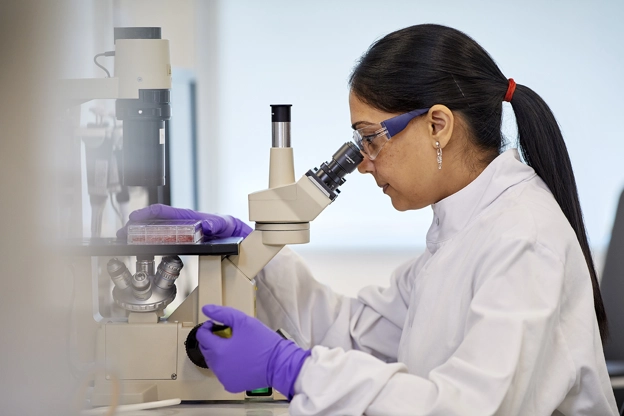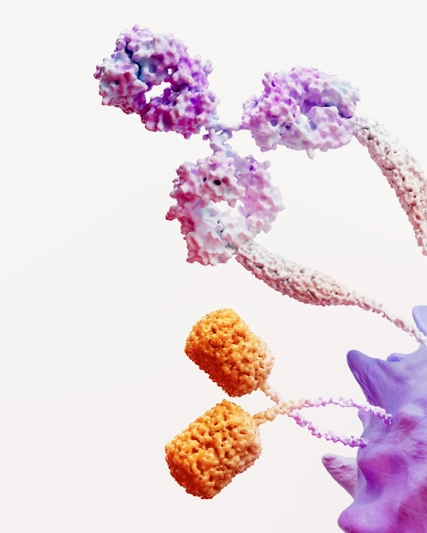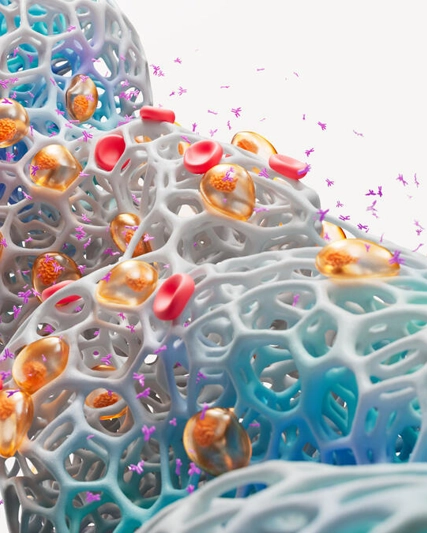Endometrial cancer
Endometrial cancer is the most common cancer that affects the female reproductive organs. In the US, ~62,000 cases are estimated to be diagnosed in 2025.

What is endometrial cancer?
-
Endometrial cancer is a type of uterine cancer, and it is found in the inner lining of the uterus, known as the endometrium. 1
-
Endometrial cancer represents over 90% of uterine cancer cases, and it is the most common type of cancer that affects the female reproductive organs in the US.2
-
Approximately 62,000 new cases of endometrial cancer are expected to be diagnosed in the US in 2025.2
What are the signs and symptoms of endometrial cancer?
There are several signs and symptoms that may indicate endometrial cancer. As the disease progresses, symptoms can become more noticeable.3 Recognizing the signs and symptoms of endometrial cancer may lead to an earlier diagnosis, when it may be more easily treated.4 However, this can sometimes be difficult because many of these symptoms are similar to other more common health conditions.3 Therefore, it is very important to listen to your body and share anything unusual with your healthcare team.
The most common symptoms of endometrial cancer are:3
-
Abnormal vaginal bleeding
-
~90% of people with endometrial cancer will experience abnormal vaginal bleeding such as a change in periods, bleeding between periods, or bleeding after menopause.
-
Non-bloody vaginal discharge
Additional common late-stage symptoms of endometrial cancer include:3
-
Pelvic pain (discomfort, pain or a feeling of fullness in the pelvis or between the hips)
-
Feeling a mass in the abdomen
-
Weight loss without trying
What is the unmet need in endometrial cancer?
-
The majority of people who have endometrial cancer are diagnosed early and are treated with surgery.4
-
However, for those whose disease recurs after platinum-based chemotherapy, there have been limited treatment options.5
-
Endometrial cancer has the highest rate of mismatch repair deficiency (dMMR) among tumor types,7 at about 30%,8 and increased rates of recurrence have been reported for some people with dMMR endometrial cancer9resulting in an unmet need for expanded treatment options.
-
In normal cells, Mismatch Repair (MMR) corrects errors that are introduced when DNA is copied in a cell. This process is what keeps the genes in a cell stable.10
-
When this process is defective it is known as Mismatch Repair Deficient (dMMR). dMMR is the result of the enzymes no longer functioning properly, leading to errors in the DNA that go unchecked.10,11
- Knowing if a tumor is dMMR can help healthcare providers learn more and predict how the tumor may respond to treatment.11
-
A dMMR system may result in the accumulation of these errors and may lead to cancer.11
How is endometrial cancer diagnosed?
- Endometrial cancer is usually diagnosed after a person visits their doctor due to a variety of abnormal symptoms. Pelvic examination, ultrasounds, CT scans, MRIs and endometrial tissue sampling may all be used to diagnose endometrial cancer.12
Who is at increased risk for endometrial cancer?
- Certain risk factors can increase the likelihood that a person will develop endometrial cancer, such as obesity, increased estrogen exposure, age, diet and exercise, type 2 diabetes, family history, treatment with radiation therapy to the pelvis and past history of atypical endometrial hyperplasia.13
Our commitment to patient education
Our programs are designed to educate and improve patient understanding regarding disease symptoms, early diagnosis and ongoing support.

Don’t Be Embarrassed
Don’t Be Embarrassed is a disease education campaign to raise awareness about endometrial cancer (EC). The goal is to educate women about the potential signs and symptoms of EC, and empower them to confront any awkwardness or social stigmas they may feel about their gynecologic health. This initiative uses humor to defuse that discomfort and encourage women to get evaluated, so that they may receive timely and appropriate care.
This novel program uses a variety of resources, including videos, to inform women of the impact of EC and encourage them to speak with their doctor if they recognize potential signs and symptoms.
Learn more here.

Our Way Forward
Our Way Forward is a call-to-action that encourages people living with gynecologic cancers, such as endometrial and ovarian cancer, their loved ones, and healthcare professionals to rethink how they talk about these cancers. The program provides ways to learn from each other’s cancer experiences and to help navigate the physical and emotional challenges that these diseases may bring.
Our Way Forward was created by the community, for the community. In 2017, GSK conducted a national survey of patients and physicians treating ovarian cancer. Along with input from advocacy organizations, these collective community insights led to the creation of Our Way Forward, a community-driven supportive resource for ovarian cancer. Since then, Our Way Forward has expanded to include resources and information for endometrial cancer.
Learn more here.
References
American Cancer Society. What is Endometrial Cancer? www.cancer.org/cancer/types/endometrial-cancer/about/what-is-endometrial-cancer.html. Updated February 28, 2025. Accessed August 2025.
American Cancer Society. Key Statistics for Endometrial Cancer. https://www.cancer.org/cancer/types/endometrial-cancer/about/key-statistics.html. Updated May 30, 2025. Accessed August 2025.
American Cancer Society. Signs and Symptoms of Endometrial Cancer. https://www.cancer.org/cancer/endometrial-cancer/detection-diagnosis-staging/signs-and-symptoms.html. Updated February 28, 2025. Accessed August 2025.
American Cancer Society. Cancer Facts & Figures 2025. https://www.cancer.org/content/dam/cancer-org/research/cancer-facts-and-statistics/annual-cancer-facts-and-figures/2024/2024-cancer-facts-and-figures-acs.pdf. Accessed August 2025.
Burke WM, et al. Gynecologic Oncology. 2014;134(2):393-402.
Le DT, et al. Science. 2017;357(6349):409-413.
Addante F, et al. Int J Mol Sci. 2024:25(2):1056.
Backes FJ, et al. Cancer. 2019;125(3):398-405.
OncologyPro ESMO. Microsatellite Instability – Defective DNA Mismatch Repair: ESMO Biomarker Factsheet. https://oncologypro.esmo.org/books/publications/publications/publications/esmo-factsheets-on-biomarkers/microsatellite-instability-defective-dna-mismatch-repair. Accessed August 2025.
National Cancer Institute. Mismatch Repair Deficiency. https://www.cancer.gov/publications/dictionaries/cancer-terms/def/mismatch-repair-deficiency. Accessed August 2025.
American Cancer Society. Tests for Endometrial Cancer. https://www.cancer.org/cancer/endometrial-cancer/detection-diagnosis-staging/how-diagnosed.html. Updated February 28, 2025. Accessed August 2025.
American Cancer Society. Endometrial Cancer Risk Factors. https://www.cancer.org/cancer/endometrial-cancer/causes-risks-prevention/risk-factors.html. Updated February 28, 2025. Accessed August 2025.


